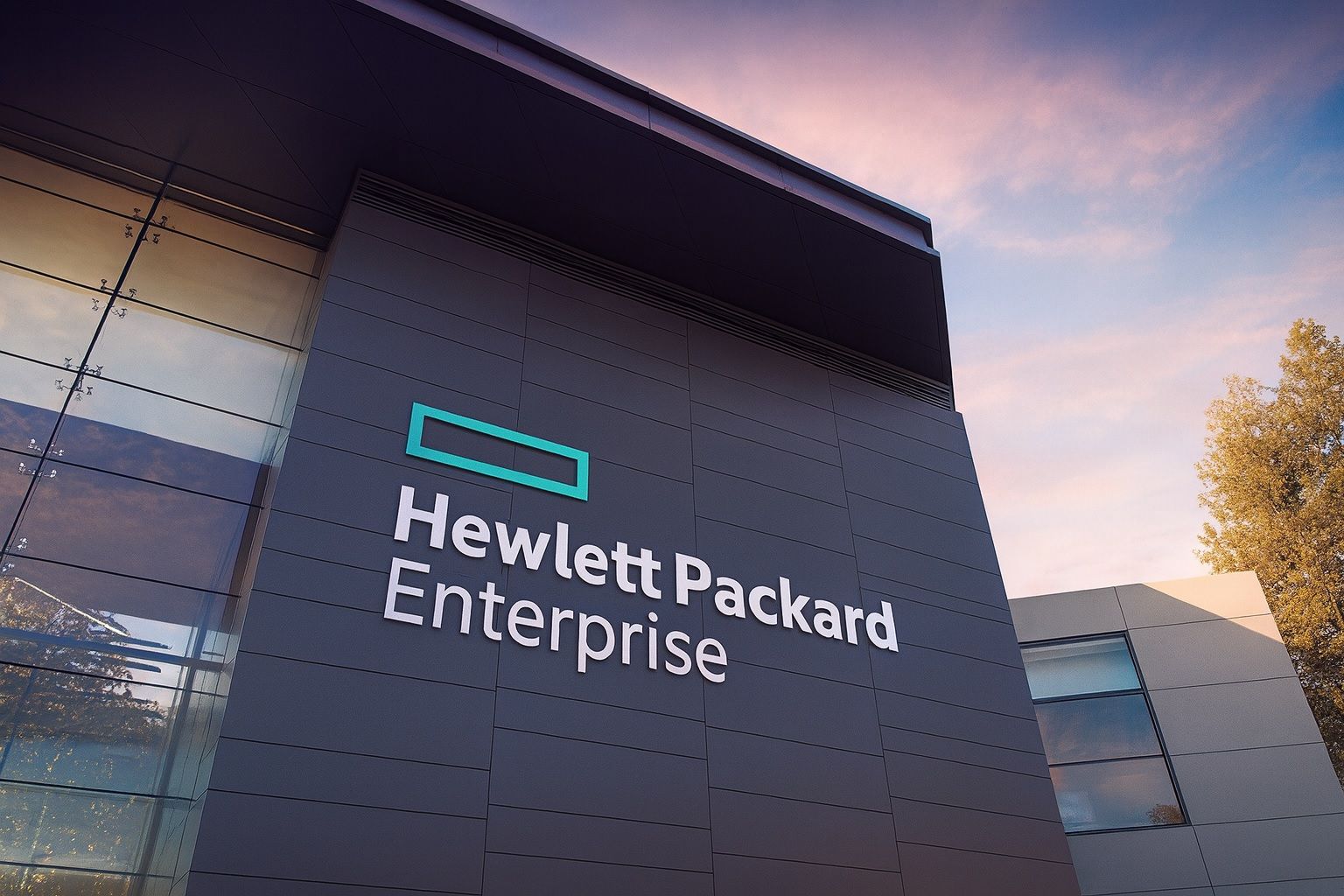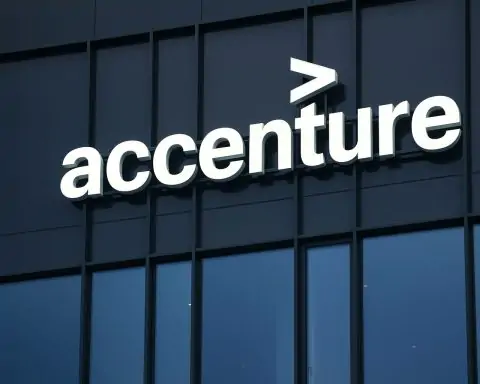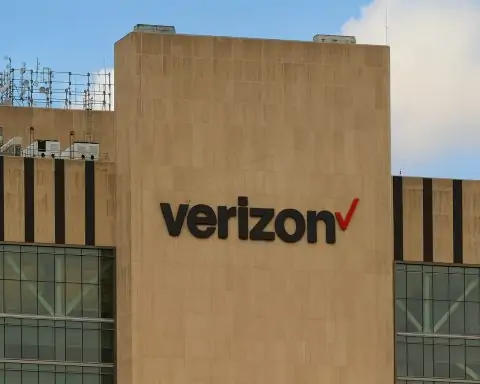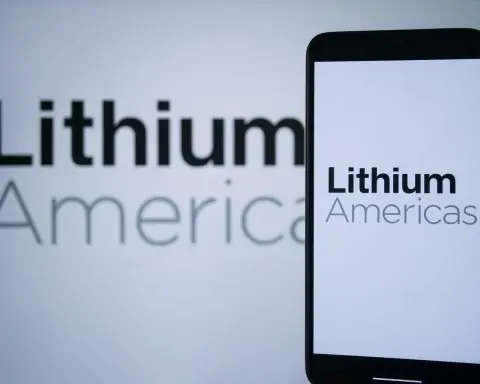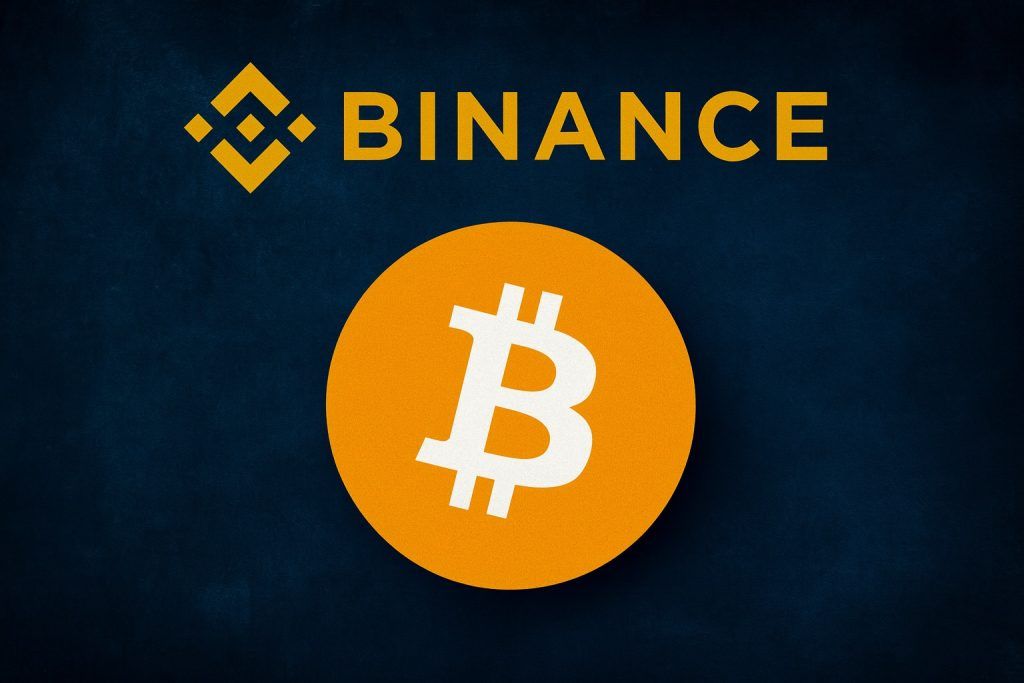- Stock Near Highs: Hewlett Packard Enterprise (NYSE: HPE) shares trade around $25 as of October 16, 2025, up roughly 16% year-to-date and recently touching a 52-week high of $26.44 [1] [2].
- Investor Meeting Highlights: On Oct. 15, HPE’s annual analyst meeting unveiled a 10% dividend hike for FY2026 and $3 billion in additional share buybacks, underscoring management’s confidence in cash generation [3].
- Guidance Disappoints: HPE’s FY2026 outlook calls for only 5–10% revenue growth and adjusted EPS of $2.20–$2.40, barely meeting consensus estimates [4] [5]. This cautious guidance fell far below Wall Street’s ~17% growth expectations [6], triggering a 5–7% after-hours drop in HPE’s stock price on Oct. 15 [7].
- AI Partnership Boost: Earlier in October, Nokia licensed HPE’s AI-powered networking technology (RAN Intelligent Controller) to enhance its telecom automation platform, highlighting HPE’s influence in next-generation 5G/6G infrastructure [8].
- Recent Earnings Momentum: In the latest quarter (Q3 FY2025), HPE’s revenue surged ~19% year-over-year to $9.14 billion (beating forecasts) driven by record sales of AI systems [9] [10]. However, quarterly EPS of $0.35 came in below expectations ($0.44), and HPE trimmed its full-year outlook, keeping investors cautious [11].
Stock Performance and Current Price
HPE’s stock has been on a strong run in 2025, gaining double digits amid optimism around the company’s cloud and AI initiatives. As of October 16, shares hover near $25, roughly 0.2% higher than the prior day’s close [12]. This price is around the average analyst price target for HPE, suggesting the stock is fairly valued for now [13]. Notably, HPE recently traded at its 52-week high of $26.44 [14] before pulling back on tempered guidance. The stock’s 50-day moving average around $23.5 reflects an uptrend in recent months [15], though its lofty year-to-date gains have moderated after this week’s news.
Long-term shareholders have enjoyed substantial returns: HPE has delivered about 23.8% gain over the past year and an impressive 211% total return over five years [16]. This steady growth underscores investor confidence in HPE’s adaptability and strategic focus. In the short term, however, volatility has picked up. The stock slipped ~6% overnight after the latest outlook update, indicating that market sentiment can swing quickly with new information. Still, at current levels HPE trades near multi-year highs, and its market capitalization stands around $33 billion [17].
Recent Developments Driving HPE Stock
Nokia Deal Underscores AI Ambitions
In early October, Nokia announced a partnership with HPE that gave the Finnish telecom giant access to HPE’s cutting-edge RAN Intelligent Controller technology [18]. Under this licensing agreement, Nokia is integrating HPE’s AI-powered networking software into its own MantaRay platform for radio access network (RAN) automation [19]. The deal even involves transferring an HPE development team to Nokia, signaling a deep collaboration in next-gen wireless infrastructure.
Why does this matter? For HPE, the Nokia tie-up validates its 5G/6G networking expertise and provides a vote of confidence from a major industry player. It shows HPE’s technology is influencing telecom networks of the future, which could open new revenue streams and partnerships. The news helped buoy HPE’s stock earlier in the month – shares were up about 7.2% at one point after the announcement [20]. Analysts noted that while this won’t radically change HPE’s financials overnight, it reinforces HPE’s credibility in AI-driven networking at a time when telcos and enterprises are racing to upgrade infrastructure [21]. It aligns with HPE’s strategy to focus on higher-margin opportunities in networking and AI, especially after its big Juniper Networks acquisition (more on that below).
Analyst Meeting: Strategy, Dividends, and Buybacks
On October 15, HPE hosted its Securities Analyst Meeting 2025 in New York – a highly anticipated event where leadership detailed the company’s strategic roadmap and financial targets through 2028 [22]. CEO Antonio Neri and his team outlined a “new chapter” for HPE centered on high-growth segments like networking, cloud, and AI, with the goal of boosting shareholder value [23] [24].
Key announcements from the meeting included shareholder-friendly moves: HPE will raise its annual dividend by 10% for FY2026 and the Board authorized an extra $3 billion for stock repurchases, bringing total buyback capacity to about $3.7 billion [25]. These steps signal management’s confidence in HPE’s cash flows and were meant to reward investors. “By aligning our investments and innovation to address the IT industry’s most promising opportunities in networking, cloud, and AI, we’re poised to gain share in the markets that matter most to our customers,” CEO Neri said at the event [26]. He emphasized that HPE’s expanded portfolio – boosted by the recent $14 billion acquisition of Juniper Networks – will drive “more profitable growth” and enable greater capital returns to shareholders [27] [28].
HPE’s strategy update highlighted several growth priorities: building a new networking leader by integrating Juniper’s products, capitalizing on the AI infrastructure boom (especially for enterprise and government “sovereign” clients), accelerating its high-margin GreenLake cloud services, and pushing into data management and next-gen server markets [29] [30]. On the cost side, HPE launched a “Catalyst” efficiency program aiming to save at least $350 million by 2028 and realize $600 million in synergies from the Juniper deal [31] [32]. All told, the company laid out an ambitious path to become leaner, more focused, and ready to seize opportunities in the AI era.
Conservative Outlook Triggers Sell-Off
While HPE’s long-term vision sounds promising, its near-term guidance gave Wall Street a reality check. At the analyst meeting, management projected fiscal 2026 (next year) revenue growth of just 5% to 10%, which “fell dramatically short” of analysts’ ~17% growth forecast [33]. Likewise, HPE’s adjusted earnings per share guidance of $2.20–$2.40 barely hit the low end of consensus (around $2.40) [34] [35]. This cautious outlook stunned many observers, given that HPE is positioning itself at the heart of a booming AI infrastructure cycle.
Investors reacted swiftly. HPE’s stock plunged about 5.7% in after-hours trading on Oct. 15 following the guidance bombshell [36]. By the next morning (Oct. 16), shares opened around $25 – down significantly from the prior day’s ~$26.50+ close. The sharp sell-off reflects skepticism about HPE’s ability to meet aggressive market expectations. As one tech news outlet put it, the gap between HPE’s conservative projections and the market’s bullish assumptions “sent shockwaves through investor circles” [37]. For a company touting its role in AI and cloud, growing only single-digits raised concerns that HPE might be struggling to fully capitalize on surging enterprise IT spending [38].
HPE defended its guidance as realistic. Executives stressed they are balancing growth with profitability and integration execution. They noted the Juniper acquisition should eventually boost HPE’s growth rate, but integration takes time, and some near-term headwinds or conservatism may be prudent [39]. Still, the “massive miss” vs. expectations [40] has left a cloud over the stock in the short run. The company’s forecast for FY2026 is essentially a reset of expectations: HPE expects to grow, but not as explosively as some had hoped during the AI hype.
In addition to growth rates, HPE’s profit and cash flow guidance drew attention. The company set a goal of at least $3.00 in non-GAAP EPS by fiscal 2028 (up from ~$1.85 expected this year) [41]. It also anticipates generating over $3.5 billion in free cash flow by 2028 [42]. However, for FY2026, EPS is only slated to rise modestly to that $2.20–$2.40 range [43]. In other words, the big gains are weighted toward later years, and investors seem to doubt whether HPE can hit those long-term targets if next year is starting slower. This skepticism is part of why the stock sold off despite the optimistic 2028 outlook.
Market Sentiment and Analyst Commentary
Analysts have reacted with a mix of caution and guarded optimism. Wall Street’s consensus on HPE is currently lukewarm: of the major analysts covering the stock, most rate it a “Hold”, with about a third on “Buy” and only one at “Strong Buy” [44]. The average 12-month price target is approximately $25, essentially where the stock trades now [45]. This suggests analysts overall see limited upside in the near term, likely due to the tempered growth outlook. As investment research firm Weiss Ratings remarked, HPE remains a “Hold” (C rating) as of early October [46], reflecting neither a strong endorsement nor a doomsday scenario.
Several analysts have trimmed their expectations in recent weeks. For example, Bernstein initiated coverage with a Market Perform and a $24 target [47], and UBS raised its target slightly to $23 (Neutral) [48] – both signaling a view that HPE’s valuation is fair, but not a bargain. Susquehanna did boost its target from $16 to $21 after HPE’s latest earnings, but kept a Neutral stance [49]. The consensus takeaway: HPE’s AI and networking story is intriguing, but show-me factors remain.
Some experts are openly questioning whether HPE can deliver the growth it promises. The Tech Buzz news site noted that for an “enterprise tech giant” at the center of AI and cloud trends, HPE’s guidance was a “sobering reality check” that raises “serious questions about HPE’s ability to capitalize on the current tech cycle” [50]. In their view, either analysts overestimated HPE’s potential or the company is facing under-the-surface headwinds that are limiting growth [51]. These could include integration challenges with Juniper, execution risks in scaling up AI hardware sales, or simply a more competitive landscape than anticipated.
Indeed, competition is a recurring theme in analyst commentary. HPE operates in a tough arena: cloud giants like Amazon and Microsoft are building more of their own data center hardware, pure-play networking rivals (e.g. Cisco) are fighting for market share, and specialized AI hardware providers (GPUs, accelerators) are grabbing budget that might have gone to traditional servers [52]. HPE’s challenge is to stay relevant and grow in this environment. The company’s strategy to double down on networking and as-a-service offerings is seen as sensible, but investors want proof it will translate to higher earnings.
On a positive note, HPE’s strong Q3 revenue performance showed that demand is there. The company’s networking segment jumped 54% year-on-year in Q3, reaching $1.7 billion [53], and its AI-focused server and storage solutions contributed to record AI system revenues of $1.6 billion in the quarter [54]. This indicates that HPE is securing big deals in the AI boom. “HPE’s pursuit of higher-growth, higher-margin opportunities [is] amid intensifying sector competition,” observed Simply Wall St analysts, “but [these wins] do not remove the hurdles posed by acquisition integration and evolving industry pricing” [55]. In other words, the growth is real but not without hiccups.
Many analysts are taking a “wait and see” approach. They’re watching upcoming earnings (HPE will report fiscal Q4 results in about a month) to gauge if the company’s margin improvements and sales momentum continue. Any evidence that HPE can exceed its conservative guidance or successfully cut costs could sway sentiment upward. Conversely, signs of integration woes or slowing orders could reinforce the cautious stance. At present, the market mood is cautious optimism – respecting HPE’s solid execution so far in 2025, but wary of the soft guidance for 2026.
Short-Term Outlook
Over the next few weeks and months, HPE’s stock may remain range-bound as investors digest the mixed messages. In the very short term, the stock’s pullback has brought it back to a valuation that most analysts consider fair. Absent any new catalysts, trading will likely be driven by broader market sentiment and tech sector trends – if tech stocks rally on AI hype or economic news, HPE could ride along, but its own news flow will be crucial.
A key upcoming catalyst is HPE’s FY2025 Q4 earnings report, expected in late November 2025. There, management’s commentary will be closely parsed for any updates to guidance or tone. If HPE delivers a solid quarter (the current Q4 consensus is around $0.58 EPS on ~$10 billion revenue [56]), it might rebuild some confidence. Investors will look for signs that HPE’s order book in AI, cloud, and networking is strong going into 2026. Any upside surprise – say, a big new GreenLake cloud customer win or faster-than-expected Juniper integration benefits – could spark a short-term rally.
Conversely, risks loom in the short term. The company’s cautious 2026 outlook means that if there are any further hiccups, sentiment could sour more. HPE is still digesting a major merger (Juniper), and such integrations can bring unexpected costs or distractions. The company also announced a 5% workforce reduction (about 2,500 jobs) in March as part of restructuring [57], which could create near-term execution risk even as it saves costs. Macroeconomic factors (like enterprise IT budget delays or higher interest rates) could also curb tech spending and affect HPE’s near-term sales.
Market technicians will note that HPE’s stock, now back around $25, might find support around the low-$20s if it falls further, given the prior trading range and the 50-day average near $23.50 [58]. On the upside, any rally beyond $26–$27 would mark new highs and likely require genuinely positive news to sustain. Short-term investors should brace for some volatility, as the stock attempts to find its footing after the recent drop. Many are essentially in “show me” mode – waiting for the next data point (earnings, guidance updates, or analyst revisions) before piling in or out.
Long-Term Forecast and Investment Outlook
Looking beyond the immediate horizon, HPE’s long-term trajectory remains promising if the company can execute on its strategy. Management’s 2025–2028 financial model envisions a steady mid-single-digit revenue CAGR of 5–7% and even stronger profit growth (operating profit up 11–17% annually) [59]. By fiscal 2028, HPE is targeting non-GAAP EPS of at least $3.00 (versus ~$1.90 in FY2025) and over $3.5 billion in annual free cash flow [60]. Achieving those goals would likely make HPE a much more valuable company than it is today.
Is that achievable? Analysts have mixed opinions. The current consensus forecast sees HPE’s revenue reaching about $44.4 billion by 2028 with earnings around $2.7 billion [61]. That implies roughly 10% compound annual revenue growth – a bit more optimistic than HPE’s own guidance, but still far below the double-digit pace some bulls hoped for. At those forecasted 2028 levels, one analysis pegs HPE’s fair value around $25.82 per share, essentially saying the stock is appropriately priced for the expected growth [62]. In other words, if HPE simply meets the current consensus trajectory, its stock might appreciate only modestly over time (aside from dividends).
However, upside scenarios do exist. If HPE over-delivers – for instance, if its pivot to AI-centric offerings and networking leadership yields higher growth or fatter margins – the stock could have much more room to run. Some valuation models point to significant undervaluation if HPE’s long-term plans come to fruition. A discounted cash flow (DCF) analysis by Simply Wall St, which factors in aggressive cash flow growth through 2035, calculates an intrinsic value of about $47.91 per share [63]. That implies HPE might be nearly 48% undervalued at current prices, presenting a sizable margin of safety for long-term investors [64]. This bullish view assumes HPE’s free cash flow will climb steadily (to over $6 billion by 2035 in that model) and that the market will eventually recognize this earnings power.
Realistically, the truth may lie somewhere in between the cautious consensus and the rosy DCF scenario. Investor expectations for HPE’s future vary widely – community estimates of fair value range from as low as ~$18 to as high as $48 [65]. Such dispersion underscores the uncertainty around HPE’s execution. Will the Juniper Networks acquisition truly transform HPE into a networking powerhouse and open new growth avenues? Can HPE expand its GreenLake cloud services fast enough to meaningfully boost margins? Will the company successfully fend off rivals and maintain relevance in the fast-evolving enterprise tech landscape? The answers will determine whether HPE’s earnings can accelerate in the latter half of the decade, or whether growth will plateau.
For long-term oriented investors, HPE offers a balanced risk-reward profile. On one hand, the stock is not expensive by tech standards – it trades around 30.5 times trailing earnings, and under 10 times the projected FY2028 earnings [66]. It also pays a decent 2.1% dividend yield (which is growing) [67], so shareholders are paid to wait. The company’s balance sheet is reasonably healthy (debt-to-equity ~0.69) [68], and it generates solid cash flow to fund buybacks and R&D. These factors provide some downside cushion. On the other hand, growth investors may find HPE’s prospects a bit slow compared to flashier tech names – mid-single-digit revenue growth and ~10% EPS growth, while respectable for an established firm, might not lead to dramatic stock appreciation unless the company surprises to the upside.
Bottom Line: HPE’s stock story in late 2025 is a tale of two narratives. In the short term, the buzz from AI deals and a booming tech market propelled the stock near highs, only to be tempered by the company’s own cautious guidance, resulting in a knee-jerk sell-off. Near-term sentiment is guarded, and the stock could remain choppy as investors await more clarity on HPE’s execution into 2026. Longer-term, HPE has laid a foundation that could yield steady growth and shareholder returns – a play on enterprise digital transformation, AI infrastructure, and networking – but it must deliver on its promises. If HPE can hit its stride in the next couple of years (integrating Juniper smoothly, growing GreenLake subscriptions, and capitalizing on AI demand), there is meaningful upside to be unlocked. If not, the stock may continue to lag the broader tech euphoria. For now, HPE stands as a stable tech stalwart with a forward dividend and a plan, striving to convince investors that today’s investments will pay off in tomorrow’s earnings [69] [70].
Sources: Recent news and analysis from TS2.tech [71], Investing.com [72] [73], The Tech Buzz [74] [75], Simply Wall St [76] [77], MarketBeat [78] [79], and HPE’s official disclosures [80] [81]. All information is accurate as of Oct. 16, 2025.
References
1. simplywall.st, 2. www.marketbeat.com, 3. www.investing.com, 4. www.investing.com, 5. www.techbuzz.ai, 6. www.techbuzz.ai, 7. www.investing.com, 8. simplywall.st, 9. www.marketbeat.com, 10. simplywall.st, 11. www.marketbeat.com, 12. www.marketbeat.com, 13. www.marketbeat.com, 14. www.marketbeat.com, 15. www.marketbeat.com, 16. simplywall.st, 17. www.marketbeat.com, 18. simplywall.st, 19. simplywall.st, 20. simplywall.st, 21. simplywall.st, 22. www.businesswire.com, 23. www.businesswire.com, 24. ts2.tech, 25. www.investing.com, 26. www.investing.com, 27. www.businesswire.com, 28. www.businesswire.com, 29. www.businesswire.com, 30. www.businesswire.com, 31. www.businesswire.com, 32. www.businesswire.com, 33. www.techbuzz.ai, 34. www.investing.com, 35. www.techbuzz.ai, 36. www.investing.com, 37. www.techbuzz.ai, 38. www.techbuzz.ai, 39. simplywall.st, 40. www.techbuzz.ai, 41. www.investing.com, 42. www.investing.com, 43. www.investing.com, 44. www.marketbeat.com, 45. www.marketbeat.com, 46. www.marketbeat.com, 47. www.marketbeat.com, 48. www.marketbeat.com, 49. www.marketbeat.com, 50. www.techbuzz.ai, 51. www.techbuzz.ai, 52. www.techbuzz.ai, 53. investors.hpe.com, 54. simplywall.st, 55. simplywall.st, 56. www.marketbeat.com, 57. www.techbuzz.ai, 58. www.marketbeat.com, 59. www.investing.com, 60. www.investing.com, 61. simplywall.st, 62. simplywall.st, 63. simplywall.st, 64. simplywall.st, 65. simplywall.st, 66. www.marketbeat.com, 67. www.marketbeat.com, 68. www.marketbeat.com, 69. www.businesswire.com, 70. www.investing.com, 71. ts2.tech, 72. www.investing.com, 73. www.investing.com, 74. www.techbuzz.ai, 75. www.techbuzz.ai, 76. simplywall.st, 77. simplywall.st, 78. www.marketbeat.com, 79. www.marketbeat.com, 80. www.businesswire.com, 81. www.businesswire.com
